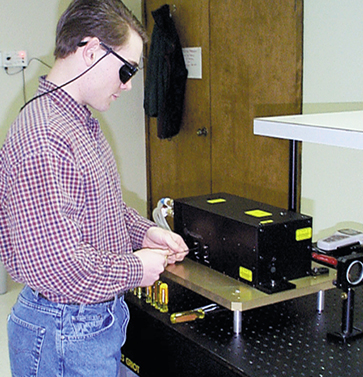Out of the Lab...Into the Real World
No longer are lasers confined to laboratory bench tops. Today, lasers are finding their niche in the fields of medicine, imaging, ranging, restoration, remote sensing, and in measuring our environment. As more and more users take lasers out of the lab, however, these powerful tools must perform reliably in "real-world" situations. Often large, delicate, and complicated to use, scientific lasers don't fit the bill for a variety of needs.
Big Sky Laser Technologies (BSLT), Inc., of Bozeman, Montana, is the developer of small, rugged commercial and developmental laser systems. Company engineers have addressed three key features demanded by laser users: equipment that is compact, rugged, and turnkey. A capacity for reliable laser operations in almost any environment was the chief design goal of the company. As a result, BSLT has introduced its Compact Folded Resonator (CFR) line-up of lasers. The CFR series is a family of highly reliable Nd:YAG lasers, crafted to take on a wide array of duties.
Through the help of TechLink of Bozeman, an organization that works to support the commercialization of NASA and other federal laboratory technologies, BSLT contacted NASA. The company's engineers determined that Langley Research Center's patent for detection and control of prelasing in a Q-switched laser would be of value to their line of products. Prelasing is a condition that occurs when light "leaks" out of the laser cavity prematurely. By applying a way to detect and control prelasing in a Q-switched laser, the deleterious effects of prelasing can be avoided.
Subsequently, BSLT applied for a non-exclusive license of the NASA technology, employing it within the company's CFR 800 laser unit. TechLink is continuing to assist the firm in commercial development and applications of the NASA technology after licensing.
As the latest addition to its CFR line of compact, rugged laser sources--the CFR 200 and CFR 400--the powerful CFR 800 features a laser head over eight times smaller than comparable systems. The CFR 800 boasts a quick and easy lamp change for its single lamp design and a total head weight of just 25 pounds. The CFR 800 is energized by a microprocessor-controlled power supply for maximum user flexibility and cooled by a closed loop, de-ionized water-to-air heat exchanger.
With laser heads up to 90 percent smaller and 75 percent lighter than scientific lasers, the CFR series allows users to take lasers where they could not go before. Taking a scientific laser out in the field can be a risky proposition. Dust, condensation, or other foreign matter inside the laser head can spell trouble. To counter these real-world worries, the CFR series of lasers is sealed with O-rings. Hermetically sealed, the laser systems can operate reliably in even the most unfavorable environments.
Applications for the CFR 800 are numerous and span a wide range of possibilities, such as Light Detection and Ranging (LIDAR), remote sensing, eye-safe illumination, ablation, and marking. The CFR 800 is marketed by BSLT as perfect for many applications in industry, science, manufacturing, research and development, and military use. Due to its small size and high-energy output, interest in the CFR 800 for a variety of uses is on the increase, according to the company.

Big Sky Laser Technologies, Inc., developed a product line of small and rugged lasers that not only can be used in the lab, but also in "real- world" situations.













